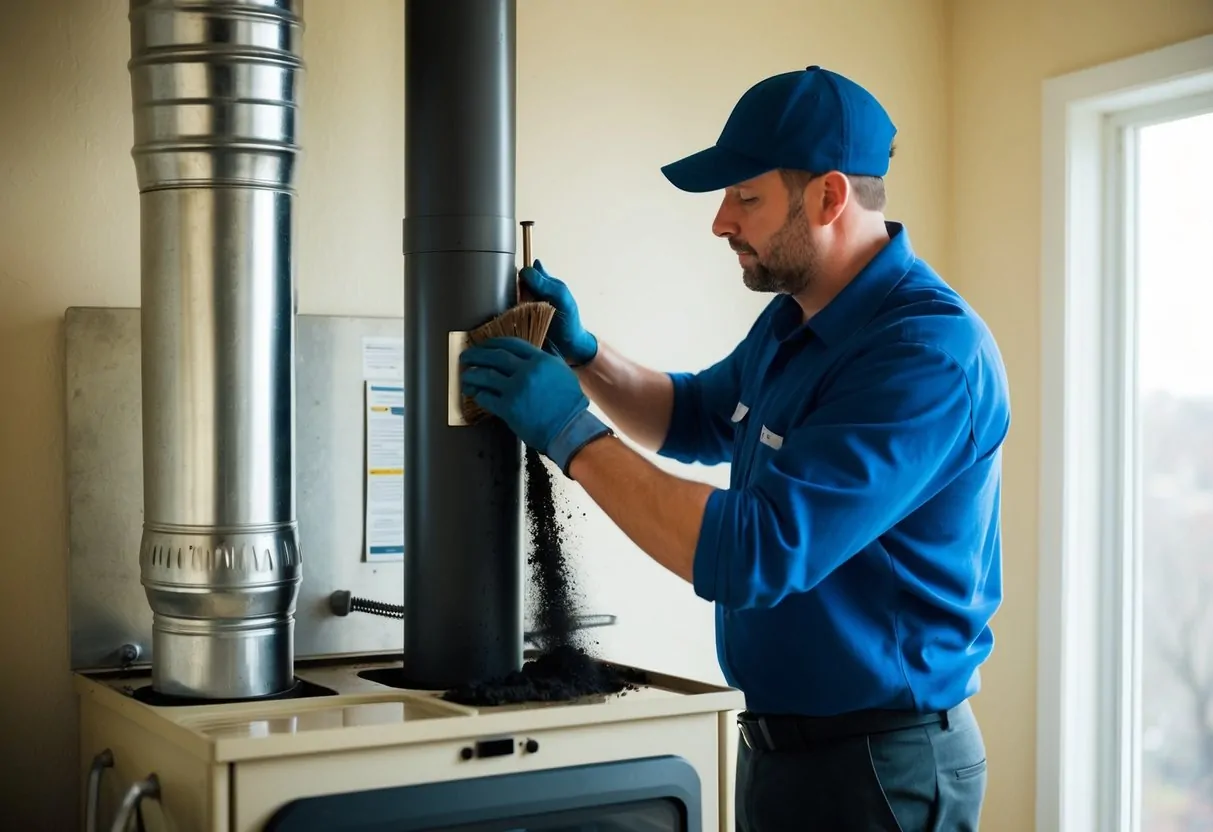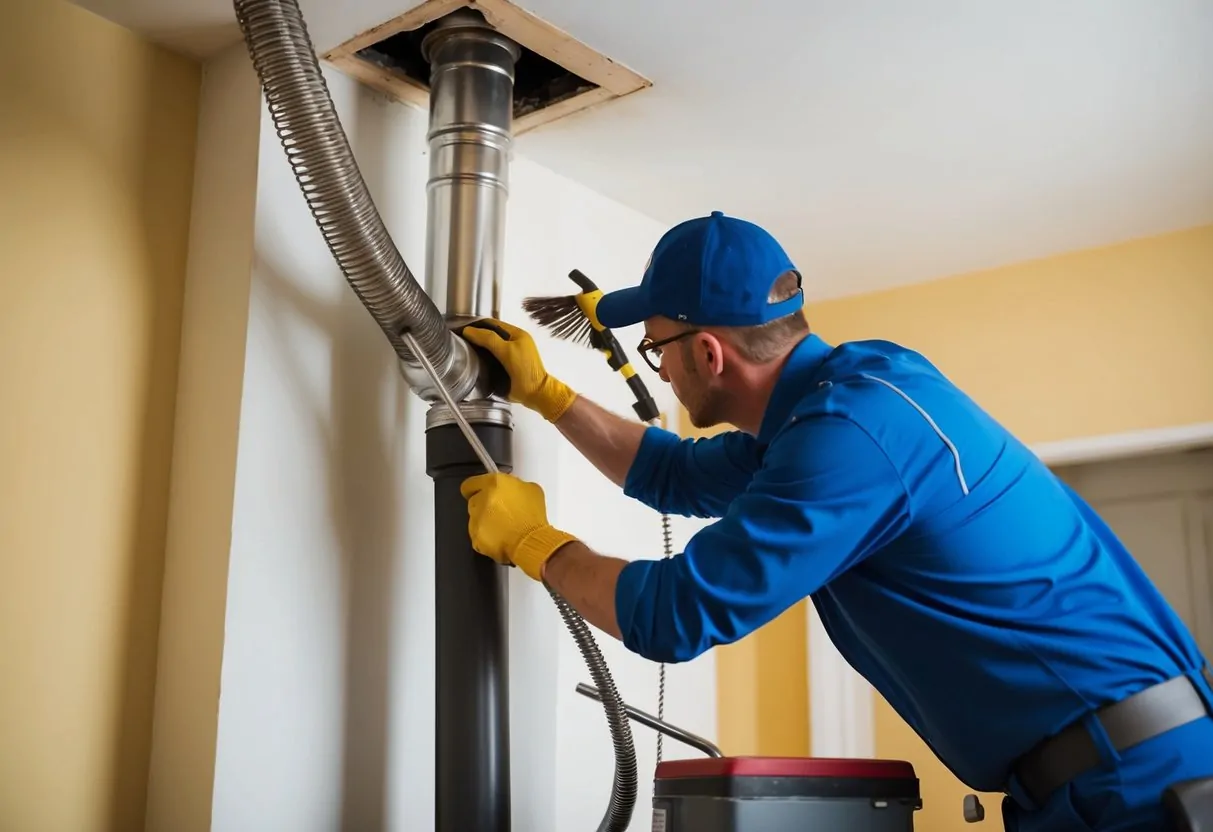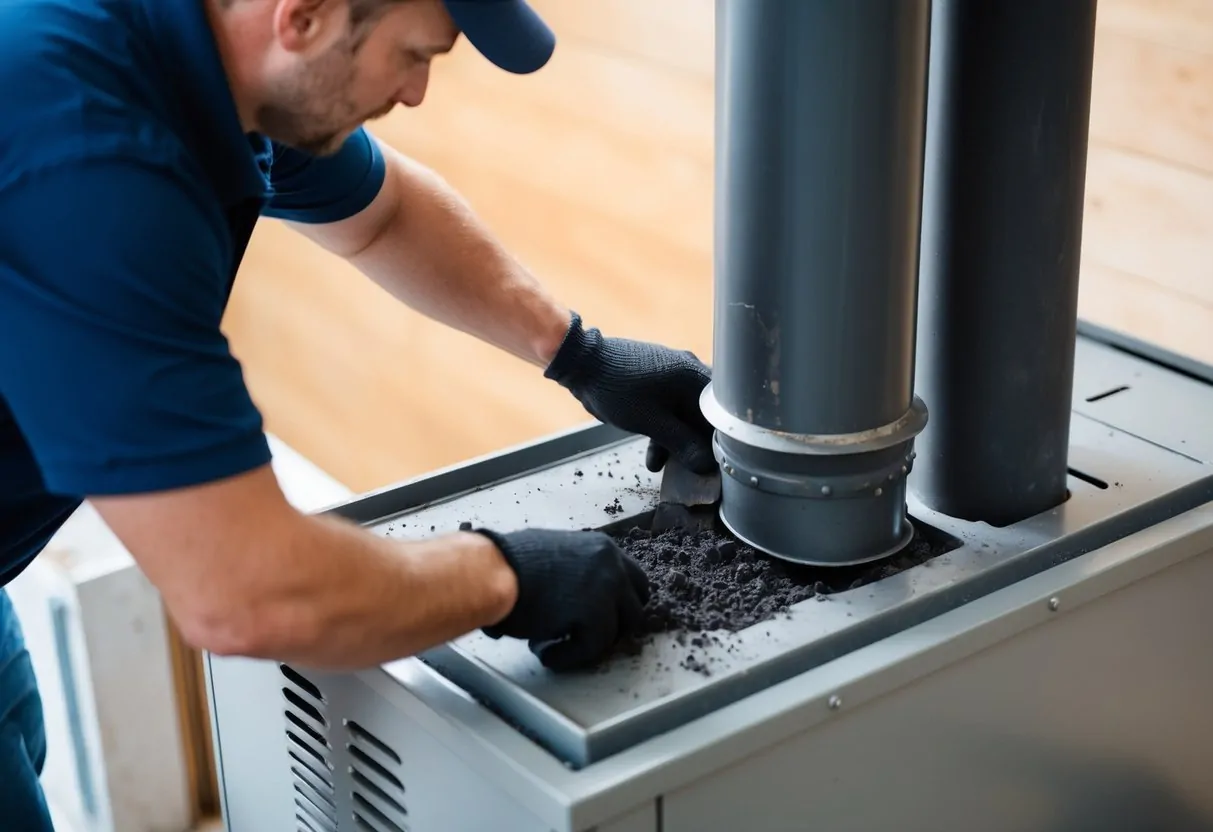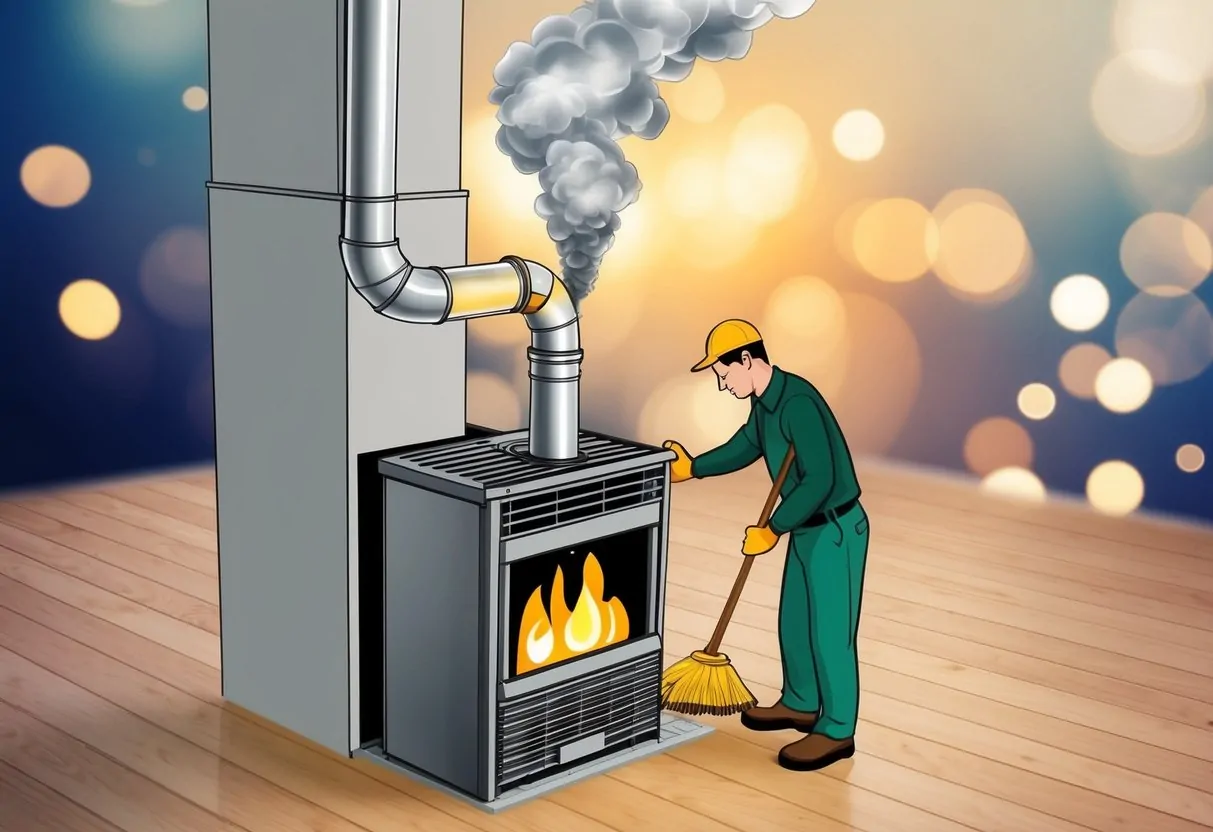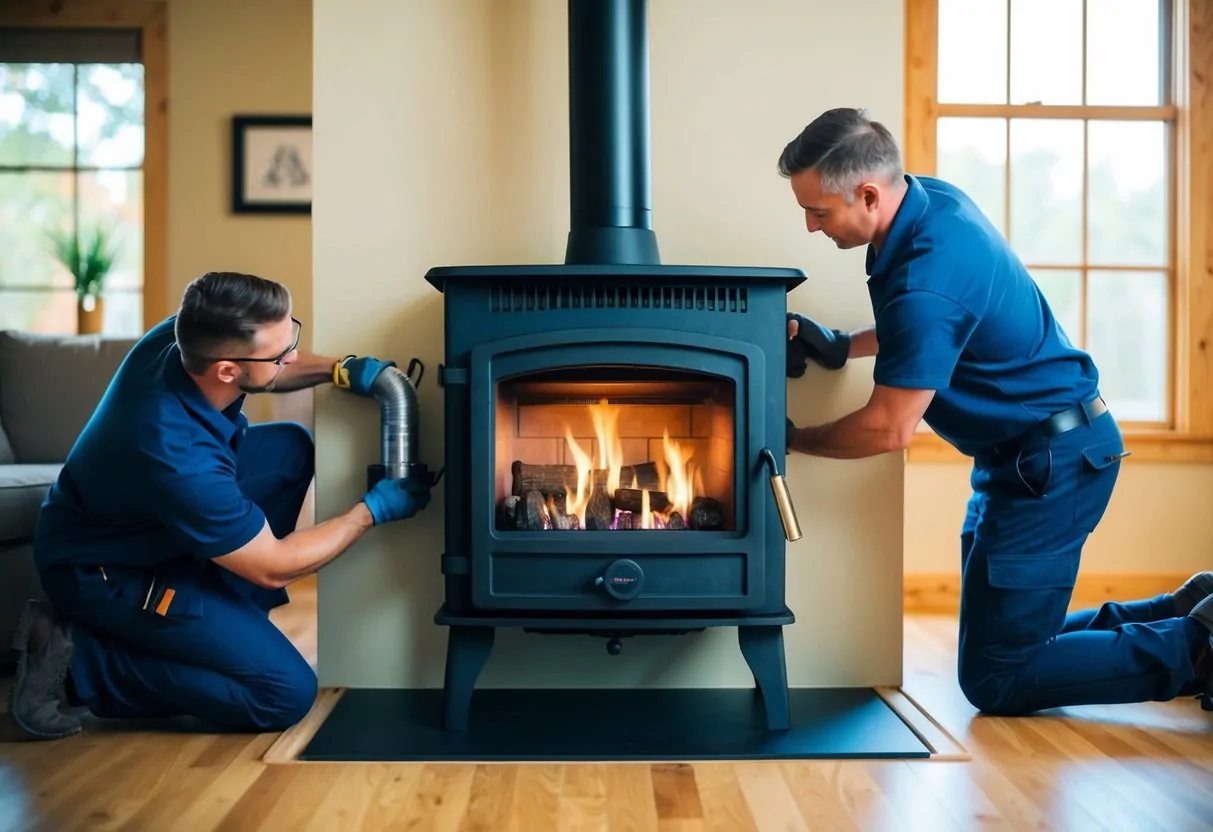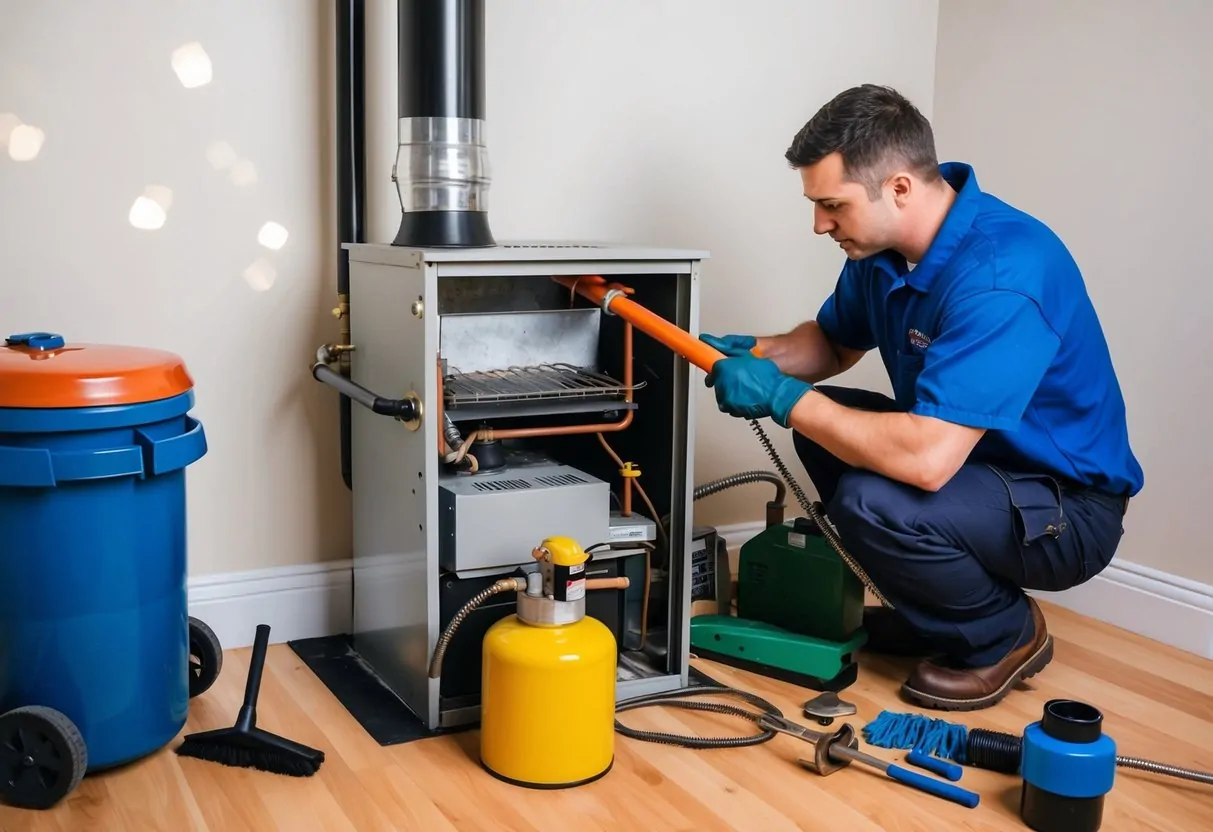Introduction
Regular maintenance of oil furnace chimneys is crucial for safe and efficient home heating. Neglecting this essential task can lead to serious safety hazards and reduced system performance. Regular chimney sweepsprevent creosote buildup, reduce fire risks, and ensure optimal furnace efficiency.
Oil furnaces produce byproducts like soot and creosote during combustion. These substances accumulate in the chimney over time, narrowing the flue and impeding proper ventilation. Reduced flue size can cause draft issues, decreased efficiency, and even carbon monoxide buildup in the home.
Professional chimney sweeps thoroughly clean and inspect the entire chimney system. They remove harmful deposits, check for structural issues, and ensure the flue is properly sized for the furnace. This comprehensive service maintains safe operation and prolongs the life of both the chimney and the heating system.
Key Takeaways
- Regular chimney sweeps prevent dangerous buildup and ensure safe furnace operation
- Professional cleaning maintains optimal efficiency and extends system lifespan
- Annual inspections detect potential issues early, avoiding costly repairs
Understanding Your Oil Furnace and Chimney System
Oil furnaces and their chimney systems work together to provide efficient home heating. The components, fuel types, and proper venting all play crucial roles in maintaining a safe and effective heating system.
Components and Functionality
An oil-fired furnace consists of several key parts. The burner mixes oil and air, igniting the mixture to produce heat. The heat exchanger transfers this heat to the air circulating through the home. The blower fan distributes warm air via ductwork.
The chimney system includes a flue pipe connecting the furnace to the chimney. The chimney itself has a flue liner to protect against heat and corrosion. A chimney cap prevents debris and animals from entering.
Oil furnaces typically operate at higher temperatures than gas furnaces. This can lead to more rapid buildup of soot and creosote in the chimney, necessitating regular cleaning.
Types of Fuel and Their Impacts
Heating oil is the primary fuel for oil furnaces. It burns hotter than natural gas, providing quick heat. However, oil can leave more residue in the system.
Some newer oil blends incorporate biofuels, which can reduce emissions and soot buildup. These may require different maintenance schedules.
Fuel quality affects furnace performance and chimney deposits. Low-quality or contaminated oil can lead to increased soot production and potential system damage.
Importance of Venting and Airflow
Proper ventilation is critical for oil furnace safety and efficiency. The chimney must effectively remove flue gases, including carbon dioxide and water vapor.
Inadequate venting can cause draft issues, reducing heating efficiency and potentially allowing dangerous gases to enter the home. A correctly sized flue ensures optimal airflow.
Regular chimney inspections check for blockages or damage that could impede proper venting. This includes examining the flue liner for cracks or deterioration.
Maintaining clean air filters and unobstructed return air vents helps the furnace operate efficiently. This ensures adequate airflow for combustion and heat distribution.
The Risks of Neglecting Chimney Maintenance
Neglecting chimney maintenance for oil furnaces poses serious risks to home safety and heating efficiency. These dangers can lead to hazardous conditions that threaten both property and occupants.
Creosote and Soot: Hidden Dangers
Creosote buildup in oil furnace chimneys presents a significant fire hazard. This highly flammable substance accumulates over time, coating the inner walls of the chimney.
Soot, another byproduct of oil combustion, can also build up excessively. Both creosote and soot reduce the chimney’s diameter, restricting proper ventilation.
This restriction can lead to: • Decreased furnace efficiency • Higher fuel consumption • Potential furnace damage
Regular cleaning removes these dangerous deposits, maintaining optimal chimney function and reducing fire risks.
Carbon Monoxide: The Silent Threat
Carbon monoxide leaks are a severe danger associated with poorly maintained chimneys. This odorless, colorless gas can seep into living spaces undetected.
Symptoms of carbon monoxide poisoning include: • Headaches • Dizziness • Nausea • Confusion
In extreme cases, it can be fatal. Proper chimney maintenance ensures that combustion gases are vented safely outside, protecting occupants from this silent threat.
Regular inspections can identify potential leaks or blockages that might lead to carbon monoxide buildup, safeguarding the home’s inhabitants.
Fire Risks and Chimney Blockages
Neglected chimneys are prone to blockages from various sources. Debris, animal nests, or even structural damage can obstruct the flue.
These blockages can: • Trap dangerous gases inside the home • Cause the furnace to malfunction • Increase the risk of chimney fires
Chimney fires are particularly dangerous, often starting unnoticed and spreading rapidly. They can cause extensive damage to the chimney structure and potentially spread to the rest of the house.
Regular inspections and cleanings remove blockages and identify potential weak points in the chimney structure, significantly reducing fire risks and ensuring safe, efficient heating.
Key Benefits of Regular Chimney Cleaning
Regular chimney cleaning offers several important advantages for homeowners with oil furnaces. It improves heating efficiency, prolongs the lifespan of your chimney and furnace, and helps prevent costly repairs and potential hazards.
Optimizing Heating Efficiency
A clean chimney significantly enhances the heating efficiency of your oil furnace system. When the chimney is free from soot and debris, it allows for proper airflow, which is crucial for optimal combustion.
This improved airflow leads to more complete fuel burning, reducing waste and lowering fuel consumption. As a result, homeowners can expect lower heating bills and a more comfortable living environment.
Regular cleanings also help maintain the chimney’s draft, ensuring that exhaust gases are effectively expelled from the home. This prevents backdrafting, which can lead to poor indoor air quality and potential health risks.
Extending Chimney and Furnace Lifespan
Routine chimney maintenance plays a vital role in extending the lifespan of both the chimney structure and the oil furnace. Accumulated soot and creosote can corrode chimney linings and damage masonry over time.
By removing these deposits regularly, homeowners can prevent deterioration and avoid costly repairs or premature replacement of chimney components. Clean chimneys also reduce stress on the furnace, allowing it to operate more efficiently and potentially last longer.
Regular inspections during cleanings can identify minor issues before they become major problems, further contributing to the longevity of the heating system.
Preventing Costly Repairs and Hazards
Regular chimney cleaning is essential for preventing expensive repairs and potential safety hazards. Accumulated creosote is highly flammable and can lead to chimney fires if not removed.
These fires can cause extensive damage to the chimney structure and even spread to the rest of the home. By keeping the chimney clean, homeowners significantly reduce this risk.
Clean chimneys also prevent blockages from debris or animal nests, which can lead to carbon monoxide buildup in the home. This invisible, odorless gas poses serious health risks and can be fatal in high concentrations.
Regular cleanings ensure proper venting of exhaust gases, maintaining a safe living environment for the household.
Professional Chimney Sweep: Expertise and Process
Professional chimney sweeps possess specialized knowledge and tools to maintain oil furnace chimneys effectively. They employ thorough inspection techniques, cleaning methods, and repair strategies to ensure optimal chimney performance and safety.
Choosing the Right Professional
Selecting a certified chimney sweep is crucial for quality service. Look for professionals with credentials from reputable organizations like the Chimney Safety Institute of America (CSIA). Certified sweeps undergo rigorous training and stay updated on industry standards.
Experience matters in chimney maintenance. Seek professionals with a proven track record and positive customer reviews. Ask about their specific expertise with oil furnace chimneys.
Reputable sweeps provide detailed written reports and recommendations. They explain their findings clearly and offer transparent pricing for their services.
Inspection and Cleaning Techniques
Professional chimney sweeps use specialized tools to inspect and clean oil furnace chimneys. They typically start with a visual examination of both the exterior and interior chimney structures.
High-tech cameras allow sweeps to inspect the entire chimney, identifying potential issues like cracks or liner damage. They assess the flue for proper sizing and draft performance.
Cleaning involves removing creosote, tar, and debris buildup. Sweeps use brushes, vacuums, and chemical treatments to thoroughly clean the chimney. They pay special attention to areas prone to accumulation.
Professionals also check connected appliances and venting systems for proper operation and safety.
Repair and Prevention Strategies
Chimney sweeps address issues found during inspection and cleaning. Common repairs include:
- Replacing damaged flue liners
- Repairing or rebuilding damaged masonry
- Fixing or replacing chimney caps and crowns
Sweeps recommend preventive measures to maintain chimney health. These may include:
- Annual inspections and cleanings
- Installation of chimney caps or spark arrestors
- Application of water-repellent sealants
They might suggest relining the flue if it’s improperly sized for the furnace. This ensures proper draft and prevents condensation issues.
Professionals also educate homeowners on proper furnace operation and maintenance to prevent future chimney problems.
When and How Often to Schedule a Chimney Sweep
Regular chimney maintenance is crucial for safe and efficient heating. Proper timing and frequency of cleaning ensure optimal performance and reduce potential hazards.
Identifying the Best Time for Maintenance
The ideal time for chimney sweeping is during the off-season, typically in late spring or early summer. This allows ample time for repairs before the heating season begins.
Scheduling in summer provides several advantages:
- Easier appointment scheduling
- More thorough inspections due to better weather conditions
- Sufficient time to address any issues discovered
Avoid waiting until fall or winter when demand for chimney services peaks. Early maintenance prevents last-minute rushes and ensures your system is ready when cold weather arrives.
Frequency of Cleaning Based on Usage
The frequency of chimney sweeping depends on how often you use your oil furnace. For typical residential use, annual cleaning is generally recommended.
Factors affecting cleaning frequency:
- Hours of daily furnace operation
- Quality of fuel used
- Efficiency of the heating system
Heavy furnace use may require more frequent cleanings. Some high-usage households might need semi-annual sweeps to maintain optimal performance.
Professional chimney sweeps can assess your specific needs and recommend an appropriate cleaning schedule based on your furnace’s condition and usage patterns.
Adjusting Schedule for Optimal Safety and Function
While annual cleaning is a good baseline, it’s important to remain flexible and adjust your maintenance schedule as needed.
Signs that may indicate the need for more frequent cleaning:
- Excessive soot buildup
- Unusual odors from the furnace
- Decreased heating efficiency
Regular inspections can help determine if your cleaning schedule needs adjustment. These checks allow professionals to spot potential issues early and recommend appropriate cleaning intervals.
Always prioritize safety. If you notice any concerning changes in your furnace’s performance, don’t hesitate to schedule an additional inspection or cleaning, even if it’s outside your regular maintenance routine.
Frequently Asked Questions
Regular maintenance of oil furnace chimneys is crucial for safety and efficiency. Understanding proper cleaning schedules, potential risks, and professional services can help homeowners maintain their heating systems effectively.
How often should a chimney connected to an oil furnace be cleaned?
Oil furnace chimneys typically require cleaning every 3-5 years. However, annual inspections are recommended to assess soot buildup and determine if more frequent cleaning is necessary.
Yearly inspections by a professional chimney sweep can identify potential issues early. Factors like furnace efficiency and fuel quality may influence cleaning frequency.
What are the risks of not regularly sweeping an oil furnace chimney?
Neglecting chimney maintenance can lead to several hazards. Soot accumulation can restrict proper ventilation, potentially causing carbon monoxide buildup in the home.
Increased fire risk is another concern. Flue gases may linger longer in an unswept chimney, leading to erosion of the liner and compromised structural integrity.
What factors affect the cost of furnace chimney cleaning services?
Chimney cleaning costs vary based on several factors. The level of soot buildup and difficulty of access can influence pricing.
Location and local market rates play a role. Additional services like inspections or repairs may also affect the overall cost.
What is the process for cleaning an oil furnace chimney?
The cleaning process begins with a thorough inspection. A professional chimney sweep will examine both the interior and exterior of the chimney.
The actual cleaning involves using specialized brushes to remove soot and debris. The sweep works from the top down, adding brush extensions as needed.
Debris is collected and removed throughout the process. A final inspection ensures all soot has been cleared and the chimney is in good condition.
Can an unswept oil furnace chimney affect heating efficiency?
Yes, a dirty chimney can significantly impact heating efficiency. Soot buildup restricts proper airflow, forcing the furnace to work harder.
This increased workload leads to higher fuel consumption and reduced overall efficiency. Regular cleaning helps maintain optimal furnace performance and can lower heating costs.
How can I find a reputable chimney sweep for my oil furnace?
Look for certified professionals with experience in oil furnace chimneys. The Chimney Safety Institute of America (CSIA) offers certification for qualified sweeps.
Ask for references and check online reviews. Reputable companies will provide detailed estimates and explain their cleaning process.

